Choke Point: China – Confronting Water Scarcity and Energy Demand in the World’s Largest Country
An escalating confrontation over resources with global implications.
中国之瓶颈:水匮乏与能源需求
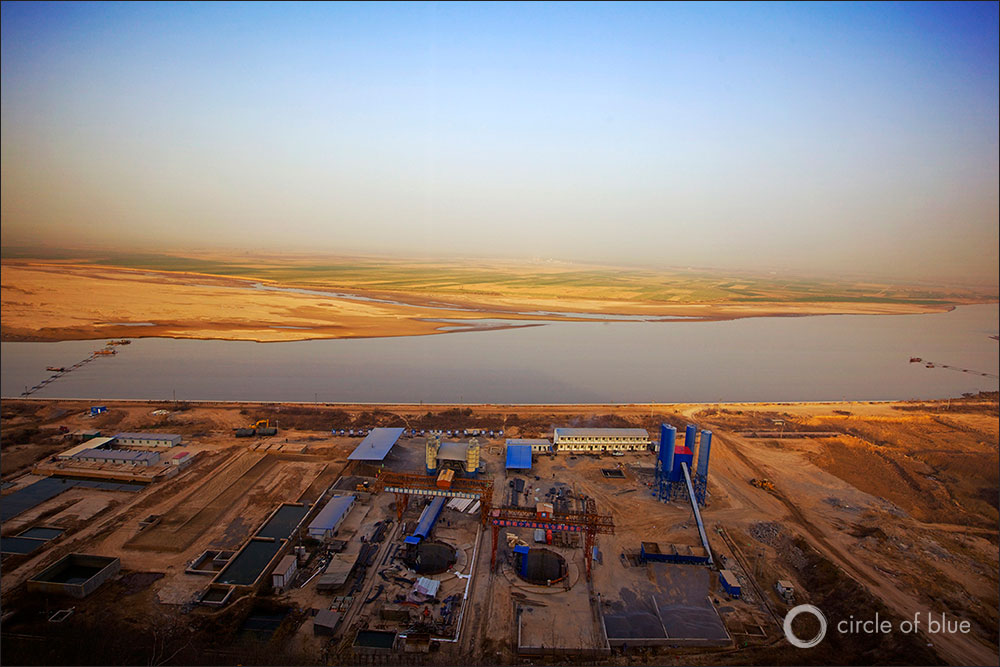
When these two tunnels beneath the Yellow River are completed by mid-decade, more than 35 million cubic meters (9 billion gallons) of water a day will be transported from southern China to thirsty cities in the north. Photo © Aaron Jaffe/Circle of Blue
By Keith Schneider, Circle of Blue
Photographs by Toby Smith/Reportage by Getty Images, and Aaron Jaffe and J. Carl Ganter/Circle of Blue
Updated
BAOTOU, Inner Mongolia — By any measure, conventional and otherwise, China’s tireless advance to international economic prominence has been nothing less than astonishing.
Over the last decade alone, 70 million new jobs emerged from an economy that this year, according to the World Bank and other authorities, generated the world’s largest markets for cars, steel, cement, glass, housing, energy, power plants, wind turbines, solar panels, highways, high-speed rail systems, airports, and other basic supplies and civic equipment to support a modern economy.
Yet, like a tectonic fault line, underlying China’s new standing in the world is an increasingly fierce competition between energy and water that threatens to upend China’s progress. Simply put, according to Chinese authorities and government reports, China’s demand for energy, particularly for coal, is outpacing its freshwater supply.
Students of Chinese history and geography, of course, understand that tight supplies of fresh water are nothing new in a nation where 80 percent of the rainfall and snowmelt occurs in the south, while just 20 percent of the moisture occurs in the mostly desert regions of the north and west. What’s new is that China’s surging economic growth is prompting the expanding industrial sector, which consumes 70 percent of the nation’s energy, to call on the government to tap new energy supplies, particularly the enormous reserves of coal in the dry north.
The problem, say government officials, is that there is not enough water to mine, process, and consume those reserves, and still develop the modern cities and manufacturing centers that China envisions for the region.
“Water shortage is the most important challenge to China right now, the biggest problem for future growth,” said Wang Yahua, deputy director of the Center for China Study at Tsinghua University in Beijing. “It’s a puzzle that the country has to solve.”
The consequences of diminishing water reserves and rising energy demand have been a special focus of Circle of Blue’s attention for more than a year. In 2010, in our Choke Point: U.S. series, Circle of Blue found that rising energy demand and diminishing freshwater reserves are two trends moving in opposing direction across America. Moreover, the speed and force of the confrontation is occurring in the places where growth is highest and water resources are under the most stress—California, the Southwest, the Rocky Mountain West, and the Southeast.
Modernization vs. Water Resources
In December, we expanded our reporting to China. Circle of Blue—in collaboration with the China Environment Forum (CEF) at the Washington-based Woodrow Wilson International Center for Scholars—dispatched four teams of researchers and photographers to 10 Chinese provinces.
Their assignment: to report on how the world’s largest nation and second-largest economy is achieving its swift modernization, despite scarce and declining reserves of clean fresh water. In essence, Circle of Blue and CEF completed a national tour of the extensive water circulatory system and vast energy production musculature that makes China go.
The result of our reporting is Choke Point: China.
In a dozen chapters—starting today and posted weekly online through April—Choke Point: China will report in text, photographs, and interactive graphics the powerful evidence of a potentially ruinous confrontation between growth, water, and fuel that is already visible across China and is virtually certain to grow more dire over the next decade.
Choke Point: China, though, is not a narrative of doom. Rather, our journalists and photographers found a powerful narrative in two parts and never before told.

The giant Baotou Iron and Steel Company plant in Inner Mongolia, one of the world’s largest, produces 10 million metric tons of steel annually in a region that receives mere inches of rainfall a year. The plant—which is 49 square kilometers and employs 50,000 workers—recycles 98 percent of its water. Photo © Toby Smith/Reportage by Getty Images for Circle of Blue
The first important finding—left largely unsaid in and outside China—is how effectively the national and provincial governments enacted and enforced a range of water conservation and efficiency measures.
Circle of Blue met the engineers, plant managers, and workers who operate China’s robust and often state-of-the-art energy and water installations. We interviewed the academics and government executives who oversee the globally significant water conservation policies and practices that have been essential to China’s new prosperity. Those policies, we found, sharply reduced waste, shifted water from agriculture to industry, and slowed the growth in national water consumption.
Though China’s economy has grown almost eight-fold since the mid-1990s, water consumption has increased 15 percent, or 1 percent annually. China’s major cities, including Beijing, are retrofitting their sewage treatment systems to recycle wastewater for use in washing clothes, flushing toilets, and other grey-water applications.
Here in Baotou, a desert city of 1.5 million in Inner Mongolia, the giant Baotou Iron and Steel Company plant, one of the world’s largest, produces 10 million metric tons of steel annually in a region that receives mere inches of rainfall a year. The plant—which is 49 square kilometers and employs 50,000 workers—recycles 98 percent of its water, a requirement of a 1997 law that prompted owners of industrial plants to conserve water.
Three Trends Converging
We also discovered a second vital narrative that most industrial executives and government authorities we interviewed were either not fully aware of or were reluctant to acknowledge: the tightening choke point between rising energy demand and declining freshwater reserves that forms the central story line of the next era of China’s unfolding development.
Stripped to its essence, China’s globally significant choke point is caused by three converging trends:
- Production of coal has tripled since 2000 to 3.15 billion metric tons a year. Government analysts project that China’s energy companies will need to produce an additional billion metric tons of coal annually by 2020, representing a 30 percent increase. Fresh water needed for mining, processing, and consuming coal accounts for the largest share of industrial water use in China, or roughly 120 billion cubic meters a year, a fifth of all the water consumed nationally.
- Though national conservation policies have helped to limit increases, water consumption nevertheless has climbed to a record 599 billion cubic meters annually, which is 50 billion cubic meters (13 trillion gallons) more than in 2000. Over the next decade, according to government projections, China’s water consumption, driven in large part by increasing coal-fired power production, may reach 670 billion cubic meters annually — 71 billion cubic meters a year more than today.
- China’s total water resource, according to the National Bureau of Statistics, has dropped 13 percent since the start of the century. In other words China’s water supply is 350 billion cubic meters (93 trillion gallons) less than it was at the start of the century. That’s as much water lost to China each year as flows through the mouth of the Mississippi River in nine months. Chinese climatologists and hydrologists attribute much of the drop to climate change, which is disrupting patterns of rain and snowfall.
“It’s just impossible, if you haven’t lived it or experienced it, to understand change in China over the past 25 years, and especially since 1992,” said Kang Wu, a senior fellow and China energy scholar at East-West Center in Hawaii.
“It’s a new world. It’s a new country. The worry in China and in the rest of the world is can they sustain it? They want to double the size of the economy again in 10 years. How can they do that? It’s a paradox from an economic point of view. They need a resource balance to meet demand, short-term and long-term. If you look out 10, 20, 30 years, it just looks like it’s not possible.”
Rapid GDP Growth Will Continue
In interviews, national and provincial government leaders, as well as energy industry executives, said China has every intention of continuing its 10 percent annual economic growth.
“We believe that this is possible and we can do this with new technology, new ways to use water and energy,” said Xiangkun Ren, who oversees the coal-to-liquids program for Shenhua Group, the largest coal company in the world.
Xiangkun acknowledged that avoiding the looming choke point will not be easy. The tightening loop is already visible in the jammed rail lines, huge coal truck traffic jams, and buckling roads that Circle of Blue encountered in Inner Mongolia—the country’s largest coal producer—and which are responsible for transporting billions of tons of coal from existing mines to market.
Energy prices are steadily rising, putting new inflationary pressure on the economy. Even as China has launched enormous new programs of solar, wind, hydro, and seawater-cooled nuclear power, all of which use much less fresh water, energy market conditions will get worse without new supplies of coal, the source of 70 percent of the nation’s energy. China’s economy and the new social contract with its citizens, who have come to expect rising incomes and improving opportunities, is at risk, say some authorities.
That’s why, as China’s economic and environmental experts sort through various scenarios to evade the approaching collision, big proposals once thought preposterous are taking hold. The idea of transporting water long distances to the arid north and west is gaining fresh credence.
A Pipeline from the Sea
For instance, one such project has stirred a national debate about costs, engineering know-how, and China’s capacity to sustain the breakneck pace of modernization. Huo Youguang—a geographer at Xi’an Jiaotong University in Shaanxi Province to the west of Beijing—has proposed a first-of-its kind seawater pipeline to supply water to Inner Mongolia’s giant coalfields.
One end of the pipe would be dropped into the Bohai Sea in China’s east. The other end, 600 kilometers to the north, would pour 340 million liters (90 million gallons) of water a day into a desalination plant in Xilinhot, a coal mining city in eastern Inner Mongolia. In between would be miles of rock tunnels cut through several mountain ranges, along with enough pumps and holding ponds to lift the water 1,300 meters.
The proposal has a single objective critical to China’s modernization, Huo said in an interview with Circle of Blue in December. The $6 billion project could provide enough water to develop some of the planet’s largest coal reserves, which otherwise cannot be tapped due to shortages of water.
He explained that the two most important natural resources that are needed to support China’s development in this decade—water and energy—are defined by what he called a “geographic mismatch.” The new energy reserves are in the dry north. The available water to develop them is in the rainy south.
“The solution to this challenge,” Huo said, “is very easy to understand. The water must be transported to where it’s needed. I am confident China will reach the same conclusion. It really doesn’t have another choice.”
A Second Big Water Transport Project in the West
Not only is the Bohai pipeline in play in provincial and national government councils, but a second big water transport project also appears to be gaining new momentum. An important researcher at the Chinese Academy of Sciences told Circle of Blue that the go-ahead for a western canal—which would transport water from the Yangtze River in the south to the headwaters of the Yellow River in the north—is likely to be included in China’s 12th Five-year Plan, the master economic development blueprint that is expected to be made public in March.
Circle of Blue learned about the revival of the western canal (once thought dead because of its cost) while reporting on two big sister canals that are under construction and will transport fresh water to Beijing, Tianjin, and other northern China cities when they are completed by 2014. The western canal finding, and its implications for northern energy development, is among the dozens of exclusive details about energy and water that will be featured in Choke Point: China.
The Coal Frenzy
Here in Baotou, China’s frantic drive to produce energy for its surging economy is visible from the summit of the Yinshan Mountain range. Trucks, backhoes, and thousands of men claw at the coal seams in the Daqing Shan open-pit coal mine, which is about an hour east of the city.
The mammoth mine—operating 24/7—is so deep that, from the ridgetop, the equipment at the bottom looks like yellow grubs digging in the dirt.
Daqing Shan produces 30 million metric tons of coal annually — a little less than 4 percent of the nearly 782 million metric tons produced in Inner Mongolia last year — all of which is hauled out in 80-ton loads on a narrow, steep, menacing concrete road, 1,000 truck loads per day.
Along the route, broken down trucks lie like dead beasts—tipped over, collapsed from fractured axles, charred from brake fires.
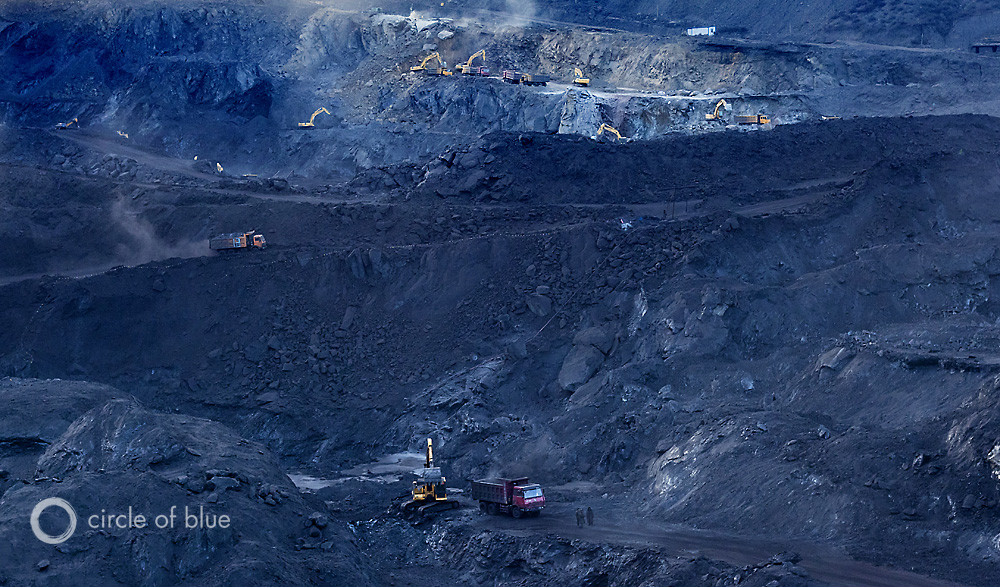
By one measure, the Daqing Shan mine is a stunning display of China’s determination to fuel its modernization. By another measure, the mine—which stretches miles in every direction—is a grim tableau of just how torturous modernization will be unless new mines can be opened. Click image to enlarge. Photo © Toby Smith/Reportage by Getty Images for Circle of Blue
By one measure, Daqing Shan is a stunning display of China’s determination to fuel its modernization. By another measure, the mine—which stretches miles in every direction—is a grim tableau of just how torturous modernization will be unless new mines can be opened.
China’s capacity to annually transport more than three billion metric tons of coal from existing mines is nearing capacity. More than 80,000 coal trains a day haul a total of 1.8 billion metric tons of coal annually on China’s railways, according to national records. Capacity is nearing the railway’s limit.
Trucks, as a result, now carry much of the rest of the country’s coal—more than one billion metric tons—from northern mines, causing traffic snarls that take hours to clear and turning paved roads to deeply rutted and barely passable trails. Even though Daqing Shan contains hundreds of millions of tons, the limit of how much coal can be transported to market each year is close to being reached.
By 2020, China will produce one billion metric tons of coal more than it is currently producing. Reaching that level will not only require more production from existing mines that have tired men and taxed machines. It will also require opening new mines in Inner Mongolia, Xinjiang, Shanxi, and other dry northern provinces. Spreading out production, and building new transportation infrastructure, will yield more coal, say industry executives, while lowering the stresses on existing mines, rails, and roads.
China certainly has enough coal. The globally significant question that hasn’t been answered, though, is where China will find enough water—perhaps 15 billion cubic meters a year—to make developing new coal reserves possible.
This post has been revised to reflect the following update:
Update: August 15, 2011
This post has been revised to reflect the March update by China’s National Bureau of Statistics, which estimated the 2010 water use at 599 billion cubic meters, instead of 591 billion cubic meters, as was reported by China’s Ministry of Water Resources in December 2010.
Keith Schneider, who has reported on energy, water, and climate change from four continents, is a Traverse City-based senior editor for Circle of Blue. Reach him at keith@circleofblue.org. Map and graphic by Kelly Shea, Tessa Tillett, Malik Cato, and Elizabeth Spangler, undergraduate students at Ball State University.
Toby Smith is a British photojournalist represented by Reportage by Getty Images who specializes in global energy and environment matters. His further work can be viewed on his website, and he can be reached at toby@shootunit.com
The Choke Point: China series is produced in collaboration with the China Environment Forum of the Woodrow Wilson International Center for Scholars.
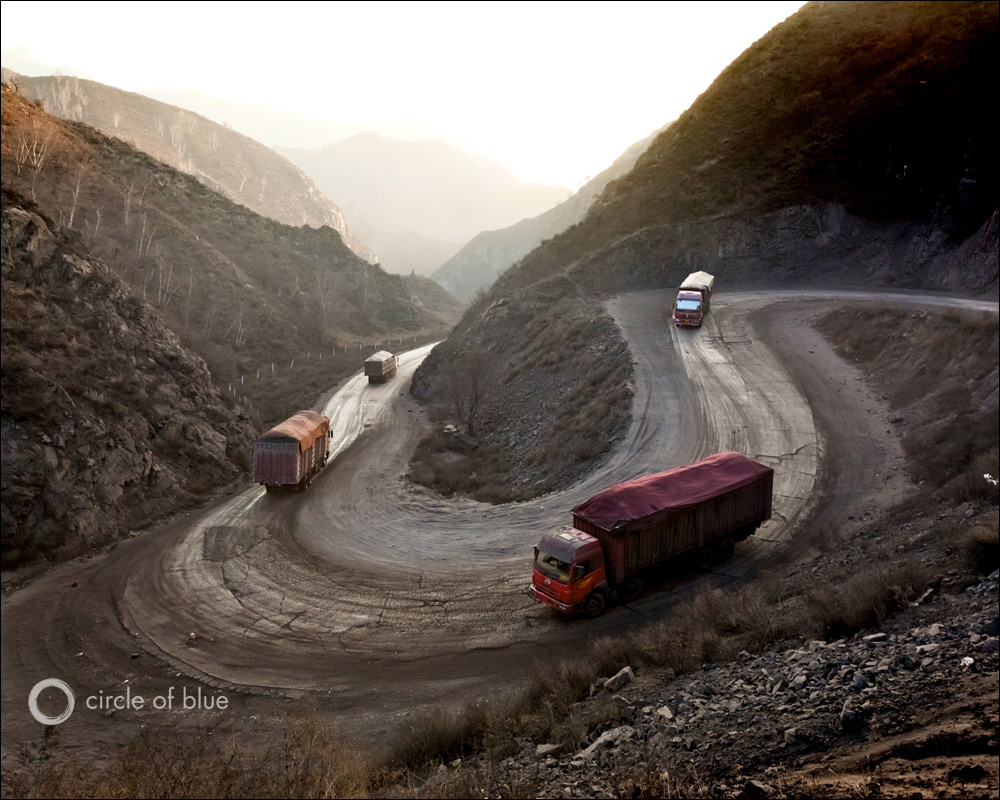
The Daqing Shan open pit coal mine, east of Baotou, produces 30 million metric tons of coal annually—a little less than 4 percent of the 782 million metric tons produced in Inner Mongolia last year —all of which is hauled out in 80-ton loads on a narrow, steep, menacing concrete road, 1,000 truck loads per day. Photo © Toby Smith/Reportage by Getty Images for Circle of Blue
Circle of Blue’s senior editor and chief correspondent based in Traverse City, Michigan. He has reported on the contest for energy, food, and water in the era of climate change from six continents. Contact
Keith Schneider


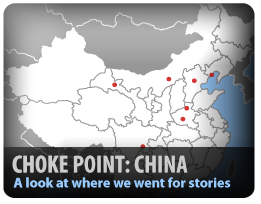
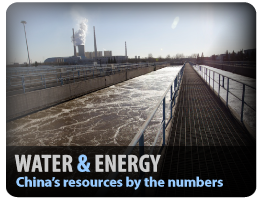
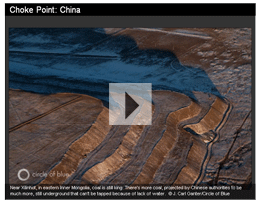
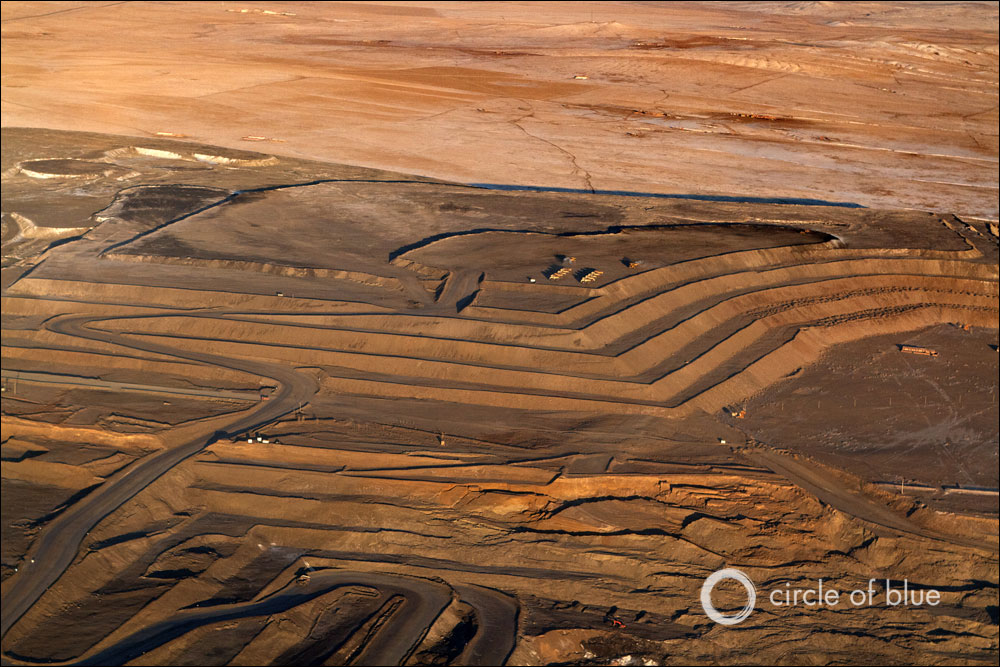


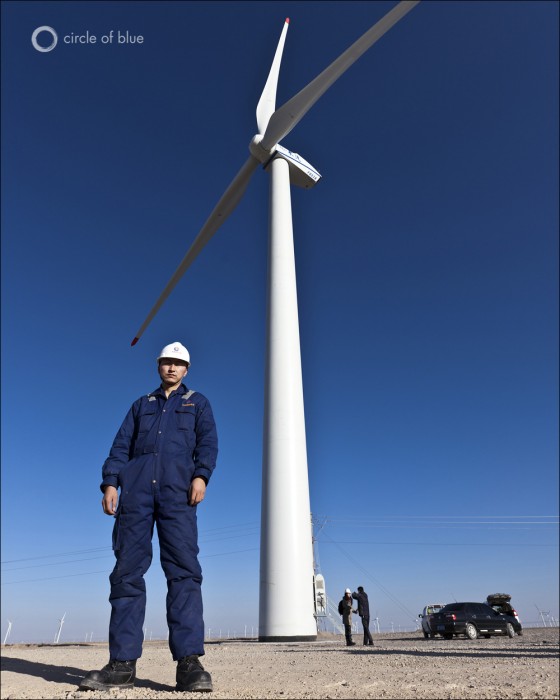


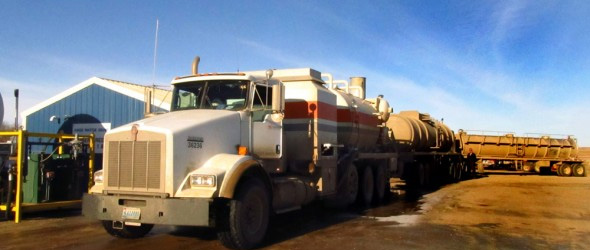



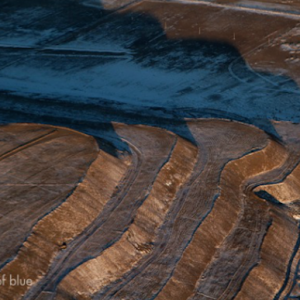
On target, yet the mystery remains how so many pundits still argue China’s future potential prominence without discussing the issues entailed in watergy compounded by toxic pollution.
Sir,
Thank you for your regular articles, but please tell me how do I save or print without all the other side advertisings,
Regards,
KC
Outstanding report. China’s massive problem is the world’s problem. More and more inhabitants spells less and less vital supply. Which holes do we plug up first in this fast sinking boat?